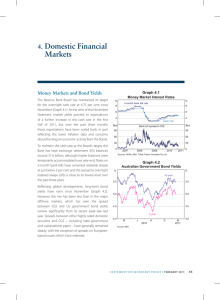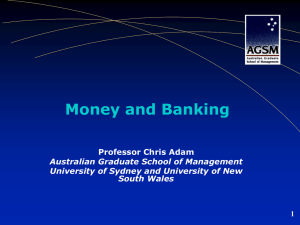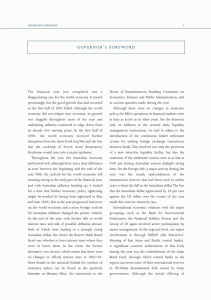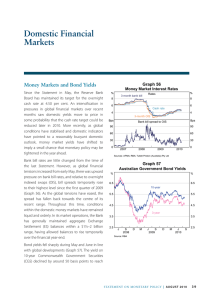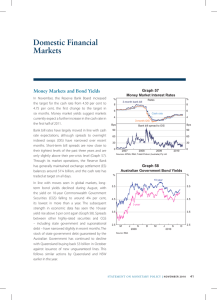Domestic Financial Markets 4. Graph 4.1
advertisement
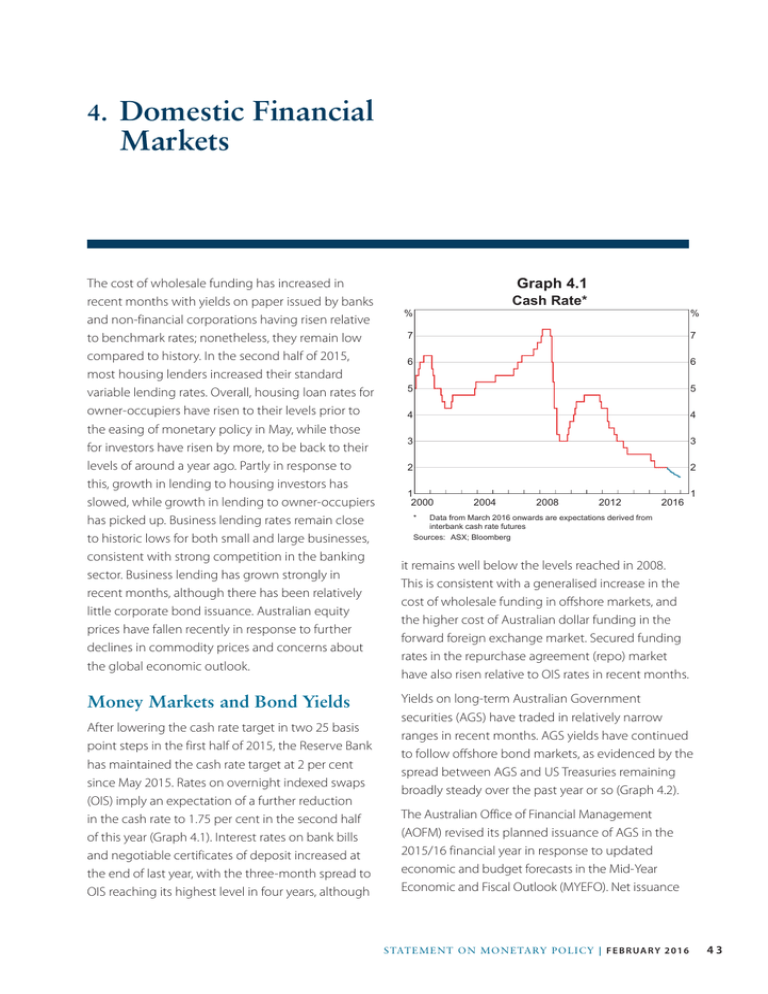
4.Domestic
Markets
Financial
The cost of wholesale funding has increased in
recent months with yields on paper issued by banks
and non-financial corporations having risen relative
to benchmark rates; nonetheless, they remain low
compared to history. In the second half of 2015,
most housing lenders increased their standard
variable lending rates. Overall, housing loan rates for
owner-occupiers have risen to their levels prior to
the easing of monetary policy in May, while those
for investors have risen by more, to be back to their
levels of around a year ago. Partly in response to
this, growth in lending to housing investors has
slowed, while growth in lending to owner-occupiers
has picked up. Business lending rates remain close
to historic lows for both small and large businesses,
consistent with strong competition in the banking
sector. Business lending has grown strongly in
recent months, although there has been relatively
little corporate bond issuance. Australian equity
prices have fallen recently in response to further
declines in commodity prices and concerns about
the global economic outlook.
Money Markets and Bond Yields
After lowering the cash rate target in two 25 basis
point steps in the first half of 2015, the Reserve Bank
has maintained the cash rate target at 2 per cent
since May 2015. Rates on overnight indexed swaps
(OIS) imply an expectation of a further reduction
in the cash rate to 1.75 per cent in the second half
of this year (Graph 4.1). Interest rates on bank bills
and negotiable certificates of deposit increased at
the end of last year, with the three-month spread to
OIS reaching its highest level in four years, although
Graph 4.1
Cash Rate*
%
%
7
7
6
6
5
5
4
4
3
3
2
2
1
2000
*
2004
2008
2012
2016
1
Data from March 2016 onwards are expectations derived from
interbank cash rate futures
Sources: ASX; Bloomberg
it remains well below the levels reached in 2008.
This is consistent with a generalised increase in the
cost of wholesale funding in offshore markets, and
the higher cost of Australian dollar funding in the
forward foreign exchange market. Secured funding
rates in the repurchase agreement (repo) market
have also risen relative to OIS rates in recent months.
Yields on long-term Australian Government
securities (AGS) have traded in relatively narrow
ranges in recent months. AGS yields have continued
to follow offshore bond markets, as evidenced by the
spread between AGS and US Treasuries remaining
broadly steady over the past year or so (Graph 4.2).
The Australian Office of Financial Management
(AOFM) revised its planned issuance of AGS in the
2015/16 financial year in response to updated
economic and budget forecasts in the Mid- Year
Economic and Fiscal Outlook (MYEFO). Net issuance
S TATE ME N T O N MO N E TARY P O L ICY | F E B R UA R Y 2 0 1 6
43
Graph 4.2
Government Bond Yields
10-year
%
6
6
Australia
4
2
%
4
United States
2
ppts
ppts
Differential
3
3
2
2
1
1
0
2006
2008
2010
2012
2014
2016
0
Sources: Bloomberg; RBA
during 2015/16 is expected to be around
$56 billion, $15 billion higher than at the time of
the 2015/16 budget, taking total AGS on issue to
around $430 billion at the end of the financial year.
State and territory governments (‘semis’) have
raised around $17 billion since the beginning of
the 2015/16 financial year, which is lower than in
preceding years (Graph 4.3). After taking account
of maturities, the total stock of bonds outstanding
increased only slightly to $243 billion. Planned
issuance under long-term borrowing programs was
revised down by a number of states (particularly
by New South Wales) in their recent mid-year
updates. This has resulted in an aggregate indicative
Graph 4.3
Bond issuance by non-residents into the domestic
market (‘Kangaroo’ issuance) was $32 billion in
2015, which was around the average of recent
years. A comparatively higher proportion of
Kangaroo issuance in late 2015 was by non AAA
rated issuers, which is consistent with a higher
level of Kangaroo issuance by corporate issuers
(see ‘Business Financing’ section for further details).
Around $4 billion in Kangaroo bonds have been
issued since the start of this year. Secondary market
spreads to AGS on AAA rated Kangaroo bonds are
broadly unchanged since November, remaining
around historically low levels.
Financial Intermediaries
The funding composition of bank balance sheets
was little changed over 2015, with the deposit share
of funding edging lower as the wholesale debt
and equity shares increased slightly (Graph 4.4).
Graph 4.4
Funding Composition of Banks in Australia*
Share of total funding
%
Quarterly
Fixed-rate issuance
Floating-rate issuance
50
50
$b
40
20
20
15
15
40
Short-term debt**
30
30
20
20
Long-term debt
10
10
5
0
5
2011
2012
2013
Sources: RBA; State Treasury Corporations
44
R ES ERV E BA NK OF AUS T RA L I A
2014
2015
%
Domestic deposits
Bond Issuance by States and Territories
$b
funding requirement of $22 billion for the 2015/16
financial year. Abstracting from refinancing needs,
net issuance for the financial year is expected to be
subdued, at around $3 billion; this primarily reflects
the funding requirement of Western Australia. The
states have issued around 75 per cent of their gross
funding target for the financial year thus far.
0
Equity
10
10
Securitisation
0
2005
2007
2009
2011
2013
2015
*
Adjusted for movements in foreign exchange rates; tenor of debt is
estimated on a residual maturity basis
**
Includes deposits and intragroup funding from non-residents
Sources: APRA; RBA; Standard & Poor’s
0
Conditions in wholesale funding markets remain
accommodative, although spreads on bank paper
have widened relative to benchmark rates. The
major banks also raised equity in the second half of
the year to meet upcoming changes to prudential
regulation.
Over 2015, debt funding costs declined by around
20 basis points more than the cash rate, reflecting
lower wholesale funding costs and reduced deposit
rates. Deposit rates have been little changed in
recent months; households have continued to
invest more in ‘at-call’ deposit savings products,
such as bonus saver accounts, consistent with the
higher rates for these products relative to term
deposits (Graph 4.5).
Graph 4.6
Net Equity Raisings
by Listed Financial Corporations
$b
25
6
20
15
15
10
10
5
5
0
0
-5
2003
Household Deposits
3-month term deposit ‘specials’
Graph 4.7
$b
6
60
5
4
4
3
3
Bonus saver accounts
Monthly change
$b
Transaction and at-call savings deposits
0
Term deposits
2008
2010
2012
2014
Australian dollar equivalent
Unsecured – offshore
Unsecured – domestic
Covered – offshore
Covered – domestic
Maturities
Buybacks
$b
60
Net issuance
30
30
0
0
10
0
-10
-5
2015
2011
Sources: ASX; RBA
%
7
5
10
2007
Australian Banks’ Bond Issuance*
Average rates of the major banks
$b
25
20
Graph 4.5
%
7
$b
Banks
Other financials
Total financials
2016
-10
Sources: APRA; Canstar Cannex; RBA
Net equity raisings by financial corporations was
around $35 billion in 2015, which is the largest
amount raised since 2009, with the bulk of this
raised by the major banks to increase their common
equity in preparation for changes to prudential
regulation (Graph 4.6). In the December quarter,
Westpac raised $3.9 billion and total financial
corporations’ net equity raisings was $7.3 billion.
Westpac’s issuance followed sizeable raisings by
each of the other major banks in earlier quarters.
Bond issuance by Australian banks in 2015 was
strong relative to the post-crisis period (Graph 4.7).
Australian banks have raised around $41 billion
-30
-30
-60
2008
*
2010
2012
2014
2016
-60
Latest quarter gross issuance and net issuance are quarter to date
Source:
RBA
since the start of November, predominantly in
offshore markets; after accounting for maturities, the
stock of bank bonds has increased by $19 billion to
$508 billion. Secondary market yields on the major
banks’ bonds have increased over recent months
while spreads to AGS and interest rate swap rates
have generally widened (Graph 4.8). The increased
spread between yields on bank bonds and interest
rate swaps suggests higher costs for new issuance.
The widening in spreads on bank paper, which is
evident elsewhere, reflects an increase in the cost of
liquidity as well as some widening in credit premia.
S TATE ME N T O N MO N E TARY P O L ICY | F E B R UA R Y 2 0 1 6
45
Graph 4.8
Major Banks’ Bond Pricing
5-year residual maturity, Australian dollar bonds
Yields
Spreads
%
bps
Financial Aggregates
Unsecured
7
Spread
to AGS
Swap
4
200
100
AGS
Spread to swap
1
2008
2012
2008
0
2016
2012
Sources: Bloomberg; UBS AG, Australia Branch
Hybrid issuance by Australian financials continued
at a moderate pace, with around $3.5 billion
issued since October, primarily in the form of Tier 2
securities issued by the major banks and insurers.
Primary market spreads on recently issued hybrid
securities were generally wider than on securities
issued earlier in 2015.
Australian asset-backed issuance totalled $30 billion
in 2015, which was around the average since 2009.
As in previous years, this was mainly RMBS issuance.
The pace of issuance has slowed in recent months,
with just three deals totalling $1.6 billion issued
since November, two of which were backed by
assets other than residential mortgages (Graph 4.9).
Graph 4.9
Quarterly
RMBS
CMBS
Other ABS
25
10
10
5
5
0
0
46
2009
2011
R ES ERV E BA NK OF AUS T RA L I A
2013
Housing
20
20
Total**
10
10
Business
0
-10
2003
0
2007
2011
2015
*
Seasonally-adjusted and break-adjusted; including securitisation
**
Includes housing, personal and business credit
The pace of housing credit growth has been steady
over the past year. Net housing debt has continued
to grow around 1 percentage point slower than
housing credit due to ongoing rapid growth in
deposits in mortgage offset accounts (Graph 4.11).
Housing loan approvals are consistent with housing
credit continuing to grow at about its current pace.
15
2007
%
25
15
RBA
Six-month-ended annualised
%
Household Financing
20
2005
Graph 4.10
Credit Growth by Sector*
$b
20
Source:
Total credit has grown by around 7 per cent in
six-month annualised terms (Graph 4.10). Housing
credit growth has been steady at around 7½ per
cent, although the composition of this growth has
shifted markedly away from investor lending and
towards owner-occupier lending. Business credit
growth picked up over the year. Growth in credit
has been a little faster than that in broad money,
which grew by around 6 per cent over the year
(Table 4.1).
Sources: ABS; APRA; RBA
Issuance of Australian ABS
$b
Primary issuance spreads on senior RMBS tranches
were wider than those issued earlier in 2015,
though they remain at relatively low levels.
2015
In the second half of 2015, most lenders increased
their standard variable housing interest rates by
15–20 basis points, after raising rates for housing
-10
Table 4.1: Financial Aggregates
Percentage change(a)
Three-month ended
Year-ended
September 2015
December 2015
December 2015
Total credit
1.9
1.6
6.6
– Housing
1.9
1.8
7.5
– Owner-occupier
1.8
2.2
6.8
– Investor
2.0
1.0
8.5
– Personal
0.2
–0.4
0.0
– Business
2.4
1.6
6.3
Broad money
1.5
1.3
6.1
(a)Growth rates are break adjusted and seasonally adjusted
Sources: ABS; APRA; RBA
Graph 4.12
Graph 4.11
Housing Credit Growth*
%
Year-ended
%
%
8
8
Housing credit
7
Interest Rates
7
8
%
8
Housing*
7
7
6
Investor
5
6
6
5
5
Net housing debt
4
4
3
3
2009
2010
2011
2012
2013
2014
2015
Seasonally and break adjusted
5
Cash rate
4
Owner-occupier
4
3
3
2
2
1
*
6
2006
*
2008
2010
2012
2014
2016
1
Estimated outstanding rate
Sources: ABS; APRA; Perpetual; RBA
Sources: ABS; APRA; RBA
investors in the middle of the year. These increases
lifted average outstanding housing interest rates
by nearly 20 basis points (Graph 4.12). Taking into
account the reductions in interest rates in the first
half of 2015, advertised standard variable housing
interest rates are around 30 basis points lower for
owner-occupiers compared to a year ago and are
little changed for investors (Table 4.2). Lenders have
not raised their advertised fixed rates to the same
extent as standard variable housing rates, with fixed
rates around 40 and 60 basis points lower over the
year for investors and owner-occupiers respectively.
Consistent with this, a higher share of mortgages
has been taken out with fixed interest rates.
There has been an increase in the dispersion of
housing interest rates across lenders over recent
months, with the major banks raising housing
interest rates by more than the mid-size lenders and
smaller lenders.
Following the introduction of differential pricing
for owner-occupier and investor loans in mid
2015, the composition of housing credit growth
has shifted towards owner-occupier lending and
away from investor lending (Graph 4.13). Sixmonth annualised owner-occupier credit growth
increased from around 5 per cent in June 2015
to around 8½ per cent in December. Conversely,
investor credit growth decreased from around
S TATE ME N T O N MO N E TARY P O L ICY | F E B R UA R Y 2 0 1 6
47
Table 4.2: Intermediaries’ Fixed and Variable Lending Rates
Interest rate
Per cent
Change over
2015
Basis points
Change since
July 2015
Basis points
Housing loans
– Standard variable rate(a) (d)
– Owner-occupier
– Investor
5.63
5.90
–30
–3
17
44
– Package variable rate(b) (d) – Owner-occupier
– Investor
4.83
5.11
–25
3
16
44
– Fixed rate(c) (d) – Owner-occupier
– Investor
– Average outstanding rate(d)
4.43
4.70
4.86
–65
–38
–29
–23
4
17
11.35
10
11
Small business
– Term loans variable rate(f )
– Overdraft variable rate(f )
– Fixed rate(c) (f )
– Average outstanding rate(d)
6.60
7.47
5.43
5.62
–50
–50
–35
–63
0
0
5
–10
Large business
Average outstanding rate(d)
3.92
–69
–4
Personal loans
– Variable rate(e)
(a)Average of the major banks’ standard variable rates
(b)Average of the major banks’ discounted package rates on new, $250 000 full-doc loans
(c)Average of the major banks’ 3-year fixed rates
(d)RBA estimates
(e)Weighted average of variable rate products
(f )Residentially secured, average of the major banks’ advertised rates
Sources: ABS; APRA; Canstar Cannex; RBA
Graph 4.13
Housing Credit Growth*
Six-month-ended annualised
%
%
Investor
30
30
20
20
Owner-occupier
10
10
0
1999
*
2003
2007
Seasonally and break adjusted
Sources: ABS; APRA; RBA
48
R ES ERV E BA NK OF AUS T RA L I A
2011
2015
0
11 per cent in June 2015 to around 6 per cent in
December. The introduction of differential pricing
also resulted in borrowers and lenders updating
the reported purpose of a large number of loans to
owner-occupier from investor; the RBA adjusts for
this when measuring investor and owner-occupier
credit growth. The net value of loan purpose
switching has amounted to $34 billion since July.
In response to lower housing interest rates over
recent years, borrowers have had the opportunity
to either reduce the principal on their loan by
making additional payments above what is
required, or to reduce their loan repayments in line
with reductions in the required repayment and
use the cash for other purposes. Household survey
data indicate that the share of households ahead
on their mortgage repayments has increased over
recent years for both owner-occupiers and investors
to its highest level since the early 2000s. These
excess repayments form a buffer for households in
the event that housing interest rates increase, as
they did in the second half of 2015.
Business Financing
Growth in external funding for businesses picked
up over recent months, driven by a faster pace of
growth in business credit and an increase in equity
raisings, while non-intermediated debt issuance has
been subdued.
Business credit growth has accelerated over recent
months, with growth over 2015 at its highest rate
since 2009. Part of the growth in 2015 is due to the
depreciation of the currency, which has increased
the Australian dollar value of foreign-currency
denominated business credit. Nevertheless, growth
has been robust even abstracting from valuation
effects. Part of the recent increase reflects greater
use of intermediated credit by businesses rather
than non-intermediated debt issuance. Business
credit growth continues to be driven by the major
banks and the foreign banks. In particular, the local
operations of Japanese and Chinese institutions
have significantly increased their business lending
over 2015 (Graph 4.14). Lending to private nonfinancial corporations has been responsible for
the majority of growth in business credit, while
growth in lending to unincorporated (typically
smaller) businesses has remained relatively steady.
Business loan approvals have increased over 2015
and remain at a relatively high level, consistent with
the faster pace of business credit growth seen in
recent months.
The average outstanding interest rate on
intermediated business borrowing has been little
changed over recent months (Graph 4.15). Since
the start of 2015, average rates on outstanding
small and large business loans have declined by
Graph 4.14
Business Credit by Source
$b
$b
Foreign banks
Major
banks
Europe
400
40
Japan
200
Foreign
banks
Other Australian
banks
20
Other
Asia
China
Americas
0
2005
2010
2015
2005
2010
2015
0
Sources: APRA; RBA
Graph 4.15
Australian Business Lending Rates*
Average interest rate on outstanding lending
%
%
10
10
Small business
8
6
8
6
Large business
4
4
2
2000
*
2004
2008
2012
2
2016
RBA estimates
Sources: APRA; RBA
over 60 basis points. Strong competition among
lenders has returned interest margins for lending to
large businesses back to the levels of the mid 2000s
(Graph 4.16). However, the recent increase in bank
bill rates is expected to flow through to a modest
increase in business borrowing rates, particularly for
those businesses with loans directly priced off bank
bill rates.
Gross bond issuance by Australian non-financial
corporations in 2015 totalled $27 billion, which was
well above 2014 levels, as a number of large issuers
returned to debt markets in the first half of the year.
However, issuance by Australian corporations was
modest in recent months, with seven issuers raising
S TATE ME N T O N MO N E TARY P O L ICY | F E B R UA R Y 2 0 1 6
49
Graph 4.16
Graph 4.17
Implied Spread on Business Lending*
Outstanding
bps
Domestic Market Corporate Bond Issuance
Quarterly, Australian dollar
bps
$b
280
280
4
4
260
260
3
3
240
240
2
2
220
220
1
1
200
0
200
2004
2007
2010
2013
2016
*
Weighted-average interest rates on lending less funding costs;
13-term Henderson trend
Large business
Sources: APRA; Bloomberg; Financial Reports;
RBA; UBS AG, Australian
Branch
around $1 billion. Kangaroo issuance by (nonresident) non-financial companies made a sizeable
contribution to domestic corporate bond market
activity with two issuers raising around $1 billion
(Graph 4.17).
Australian corporate bond yields have risen in
recent months, leading to a significant widening
in corporate bond spreads relative to benchmark
rates; this widening has been more pronounced
for bonds issued by resource-related corporations
and for bonds issued offshore (Graph 4.18). While
resource companies’ bond spreads have typically
been marginally narrower than spreads for nonresource companies in recent years, they are
currently around 75 basis points wider, as these
companies face weaker conditions in commodities
markets.
The credit ratings agencies have made downward
revisions to their price assumptions on a number
of commodities for the next couple of years, which
has affected the credit ratings of some Australian
non-financial corporations. Since the start of
November, 23 (mostly resource-related) companies
have experienced downgrades to their credit
ratings or outlooks, or been placed on review for a
downgrade.
50
R ES ERV E BA NK OF AUS T RA L I A
$b
Resident
Non-resident ('Kangaroos')
2007
Source:
2009
2011
2013
2015
0
RBA
Graph 4.18
Australian Corporate Bond Pricing
%
6
Investment grade bonds, 5-year target tenor
Yield
Spread to AGS
Resource-related
firms
Other
non-financial
firms
3
bps
300
200
AGS
0
2012
2015
2012
2015
Sources: Bloomberg; RBA; S&P Capital IQ
Non-financial corporations (including real estate
companies) raised $26 billion in net equity in 2015,
which was slightly lower than in 2014 (Graph 4.19).
IPO activity proceeded at a moderate pace in
2015 following a large number of new listings in
2014. There was a strong pick-up in equity raisings
in the December quarter, with $13 billion raised
predominantly by already listed corporations; this
included capital raisings by energy companies
seeking to pay down debt and strengthen their
balance sheets following falls in oil prices.
100
Graph 4.19
Equity Raisings by Non-financial Corporations*
$b
$b
IPOs
5
5
$b
25
$b
25
Raisings by already listed corporations
20
20
15
15
10
10
5
5
$b
0
$b
0
Buybacks by already listed corporations
-5
-10
-5
2003
2006
Resources
*
2009
Real estate
2012
2015
Infrastructure
Other
Excludes financial corporations other than real estate; excludes
hybrid conversions
-10
Equity Markets
Australian equity prices fell by 2 per cent over 2015,
with sharp falls in commodity prices weighing on
the resources sector (Graph 4.20; Table 4.3). Since
the start of 2016, equity prices have fallen by 8 per
cent alongside an increase in global share market
volatility and further falls in oil prices. The Australian
market generally underperformed global equity
markets over 2015; however, this underperformance
can be partly attributed to the higher dividends that
are paid by Australian companies. On a total return
basis, Australian equities rose by 3 per cent over
2015, outperforming the US but underperforming
European markets.
Graph 4.20
Sources: ASX; RBA
Merger and acquisition (M&A) activity increased
in 2015 with $85 billion in deals announced by
listed companies. Activity was supported by the
lower Australian dollar and interest from foreign
buyers. M&A activity picked up in the December
quarter with around $39 billion announced. This
was concentrated in the financials and industrials
sectors, and partly reflected takeover interest
in Asciano, including a restructured offer from
Brookfield Infrastructure Partners and rival interest
from a consortium led by Qube.
Share Price Indices
End December 2008 = 100
index
index
220
220
S&P 500
190
190
160
160
130
ASX 200
100
100
MSCI World excluding US
70
2010
2012
130
2014
2016
70
Sources: Bloomberg; Thomson Reuters
Table 4.3: Equity Markets
Percentage change
Australia (ASX 200)
– Resources
– Financials
– Other
Europe (Eurostoxx)
United States (S&P 500)
World (MSCI)
2014
2015
2016 to date
1.1
–19.0
6.5
6.1
1.7
11.4
7.2
–2.1
–7.9
–14.2
–10.3
–3.7
–10.3
–6.8
–7.5
–28.8
0.7
6.5
8.0
–0.7
–0.7
Source: Bloomberg
S TATE ME N T O N MO N E TARY P O L ICY | F E B R UA R Y 2 0 1 6
51
Resources sector share prices fell by 29 per cent
over 2015, and have fallen a further 14 per cent
since the start of this year (Graph 4.21). Share
prices for this sector are now at their lowest level
in over 10 years; at the end of 2015, the sector
accounted for 16 per cent of the ASX 200 by market
capitalisation, down from 24 per cent around two
years ago.
The materials sector has declined by around 28 per
cent since mid October alongside the fall in the iron
ore price (Graph 4.22). Energy sector share prices
have declined by 20 per cent, with oil prices falling
by roughly 30 per cent over this period. Partially
offsetting the negative effect of lower commodity
prices has been continued cost cutting, particularly
by the major diversified miners.
After being little changed over 2015, financial sector
share prices have fallen by around 10 per cent since
the start of this year driven by banks and diversified
financials, and has occurred alongside falls in
financial share prices globally.
Equity prices for companies outside the resources
and financial sectors rose by 7 per cent over 2015.
These companies have continued to outperform
the broader index in aggregate since the start of
this year, with a number reporting an improved
outlook for earnings.
Graph 4.21
Australian Share Price Indices
500
Resources
400
400
300
300
200
100
All other sectors
0
2004
Source:
2008
100
0
2016
2012
Bloomberg
Graph 4.22
Resources Share Prices and Commodity Prices
End December 2014 = 100, log scale
index
index
Materials sector
100
70
100
70
Iron ore*
index
index
100
100
Brent oil
70
70
Energy sector
40
M
*
J
2015
S
D
M
2016
40
Qingdao import iron ore spot price
Sources: Bloomberg; RBA; Thomson Reuters
Graph 4.23
ratio
ASX 200 Forward Price-earnings Ratios
Resources
Other
20
ratio
20
15
15
Average
since 2003
10
Financials
10
ASX 200
ratio
15
15
10
10
5
2006
Source:
R ES ERV E BA NK OF AUS T RA L I A
200
Financials
ratio
52
index
500
Analyst earnings expectations for 2015/16 and
2016/17 have been revised lower in recent months,
with resources sector earnings expectations having
fallen alongside further commodity price declines.
Valuations of Australian equities, as measured
by forward price-earnings ratios, have declined
in recent months reflecting lower share prices.
Valuations remain above or around their long-term
averages across all the broad sectors (Graph 4.23). R
End December 2000 = 100
index
2011
Thomson Reuters
2006
2011
5
2016
